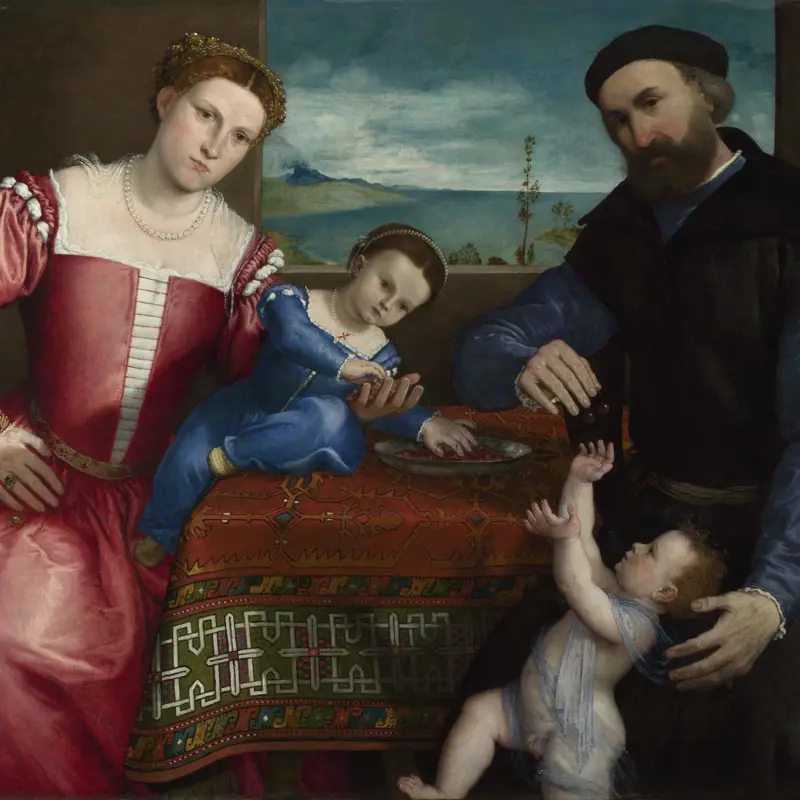Lorenzo Lotto, 'The Virgin and Child with Saints', 1522
About the work
Overview
No other Renaissance painting of the Virgin and Child with saints shows the naked infant Christ sitting on a pillow on a coffin. This unique addition indicates Christ’s acceptance of and conquest over death. Meditation on Christ’s death encouraged understanding of his suffering for humanity’s redemption.
A tear falls from the elderly Saint Jerome’s eye as he clasps his hand to his chest and contemplates a figure of the crucified Christ. Saint Nicholas of Tolentino, wearing the black habit of the Augustinian Order, has a sacred radiance glowing on his chest and holds a lily.
There is another better-preserved and higher-quality version of this painting at the Museum of Fine Arts, Boston. Lotto appears to have worked on both pictures at the same time, drawing and resolving the composition in the Boston version and then reproducing it on the National Gallery’s canvas. The pictures were probably painted towards the end of the period that Lotto spent mainly in Bergamo.
Key facts
Details
- Full title
- The Virgin and Child with Saints Jerome and Nicholas of Tolentino
- Artist
- Lorenzo Lotto
- Artist dates
- About 1480 - 1556/7
- Date made
- 1522
- Medium and support
- Oil on canvas
- Dimensions
- 91 × 75.4 cm
- Inscription summary
- Signed; Dated
- Acquisition credit
- Bequeathed by Martin Colnaghi, 1908
- Inventory number
- NG2281
- Location
- Room 5
- Collection
- Main Collection
- Previous owners
- Frame
- 17th-century Florentine Frame
Provenance
Additional information
Text extracted from the ‘Provenance’ section of the catalogue entry in Nicholas Penny, ‘National Gallery Catalogues: The Sixteenth Century Italian Paintings’, vol. 1, ‘Paintings from Bergamo, Brescia and Cremona’, London 2004; for further information, see the full catalogue entry.
Bibliography
-
1895B. Berenson, Lorenzo Lotto: An Essay in Constructive Art Criticism, London 1895
-
1901A. Venturi, Storia dell'arte italiana, 11 vols, Milan 1901
-
1908Royal Academy of Arts, Works by the Old Masters and Deceased Masters of the British School (exh. cat. Royal Academy of Arts, 1908), London 1908
-
1953P. Zampetti, Mostra di Lorenzo Lotto: Catalogo ufficiale (exh. cat. Palazzo Ducale (Venice), 14 June - 18 October 1953), Venice 1953
-
1959Gould, Cecil, National Gallery Catalogues: The Sixteenth Century Venetian School, London 1959
-
1975C. Gould, Delaroche and Gautier: Gautier's Views on the 'Execution of Lady Jane Grey' and on other Compositions by Delaroche, London 1975
-
1978R. Goffen, 'A Madonna by Lorenzo Lotto', MFA Bulletin, LXXVI, 1978, pp. 34-41
-
1979J. Mills and R. White, 'Analyses of Paint Media', National Gallery Technical Bulletin, III, 1979, pp. 66-7
-
1980F. Caroli, Lorenzo Lotto e la nascita della psicologia moderna, Milan 1980
-
1983P. Bensi, 'Per l'arte: Materiali e procedimenti pittorici nell'opera di Lotto', Studi di storia delle arti, V, 1983, pp. 63-111
-
1987Gould, Cecil, National Gallery Catalogues: The Sixteenth Century Italian Schools, London 1987
-
1991D. Ekserdjian, 'A Note on Lorenzo Lotto's "Virgin and Child with Saint Jerome and Saint Nicholas of Tolentino"', Journal of the Museum of Fine Arts, Boston, III, 1991, pp. 87-91
-
1996J. Bonnet, Lorenzo Lotto, Paris 1996
-
1997P. Humfrey, Lorenzo Lotto, New Haven 1997
-
1997D.A. Brown, P. Humfrey and M. Lucco, Lorenzo Lotto: Rediscovered Master of the Renaissance (exh. cat. National Gallery of Art, Washington, 2 November 1997 - 1 March 1998; Accademia Carrara, 2 April - 28 June 1998; Grand Palais, 12 October 1998 - 11 January 1999), Washington 1997
-
1998J. Dunkerton, N. Penny and A. Roy, 'Two Paintings by Lorenzo Lotto at the National Gallery', National Gallery Technical Bulletin, XIX, 1998, pp. 52-63
-
2000A. Gentili, 'Lotto, Cariani e storie di scoiattoli', Venezia cinquecento, X/20, 2000, pp. 5-38
-
2001
C. Baker and T. Henry, The National Gallery: Complete Illustrated Catalogue, London 2001
-
2002C. Barbieri, 'La peste, l'intercessione dei santi e la "vera medicina": Lorenzo Lotto a Credaro', Iconographica, I, 2002, pp. 135-52
-
2002D. Bomford et al., Underdrawings in Renaissance Paintings (exh. cat. The National Gallery, 30 October 2002 - 16 February 2003), London 2002
-
2004
Penny, Nicholas, National Gallery Catalogues: The Sixteenth Century Italian Paintings, 1, Paintings from Bergamo, Brescia and Cremona, London 2004
-
2005V. Pace and R. Tollo, San Nicola da Tolentino nell'arte: Corpus iconografico, Tolentino 2005
About this record
If you know more about this work or have spotted an error, please contact us. Please note that exhibition histories are listed from 2009 onwards. Bibliographies may not be complete; more comprehensive information is available in the National Gallery Library.



